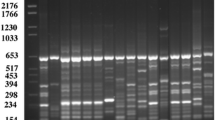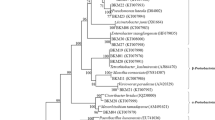Abstract
Characterization of the rhizobacteria of native grasses naturally colonizing abandoned mine sites may help in identification of microbial inoculants for ecological-restoration programmes. Eighty one strains of Saccharum munja rhizobacteria isolated from an abandoned mine located on Aravalli mountain and 50 from bulk-region were identified using 16S rRNA sequence analyses. Based on chemical- and biological-assays they were categorized into ecologically diverse functional groups (siderophore-, IAA-, ACC-deaminase-, HCN-, polyphosphate-producers; phosphate-solubilizer; antagonistic). Eight genera, 25 species from rhizosphere and 2 genera, 5 species from bulk-region were dominated by Bacillus spp. (B. barbaricus, B. cereus, B. firmus, B. flexus, B. foraminis, B. licheniformis, B. megaterium, B. pumilus, B. subtilis, B. thuringiensis) and Paenibacillus spp. (P. alvei, P. apiarius, P. lautus, P. lentimorbus, P. polymyxa, P. popillae). Siderophore-producers were common in rhizosphere and bulk soil, whereas IAA-producers, N2-fixers and FePO4-solubilizers dominated rhizosphere samples. During the reproductive phase (winter) of S. munja, siderophore-, ACC-deaminase- and polyP-producers were predominant; however dominance of HCN-producers in summer might be associated with termite-infestation. In vivo ability of selected rhizobacteria (B. megaterium BOSm201, B. subtilis BGSm253, B. pumilus BGSm157, P. alvei BGSm255, P. putida BOSm217, P. aeruginosa BGSm 306) to enhance seed-germination and seedling-growth of S. munja in mine-spoil suggest their significance in natural colonization and potential for ecological-restoration of Bhatti mine.


Similar content being viewed by others
References
Bakker AW, Schippers B (1987) Microbial cyanide production in the rhizosphere in relation to potato yield reduction and Pseudomonas spp.-mediated plant growth inhibition. Soil Biol Biochem 19:451–457
Boddey RM (1995) Biological nitrogen fixation in sugar cane: a key to energetically viable biofuel production. Crit Rev Plant Sci 6:209–266
Boyer S, Wratten SD (2010) The potential of earthworms to restore ecosystem services after opencast mining—a review. Basic Appl Ecol. doi:10.1016/j.baae.2009.12.005
Bric JM, Bostock RM, Silverstone SE (1991) Rapid in situ assay for indoleacetic acid production by bacteria immobilized on a nitrocellulose membrane. Appl Environ Microbiol 57:535–538
Burd GI, Dixon DG, Glick BR (1998) A plant growth promoting bacterium that decreases nickel toxicity in seedlings. Appl Environ Microbiol 64:3663–3668
Cattelan AJ, Hartel PG, Fuhrmann JJ (1999) Screening for plant growth-promoting rhizobacteria to promote early soybean growth. Soil Sci Soc Am J 63:1670–1680
Chatterjee R, Gupta BK, Mohiddin SK, Singh PN, Shekhar S, Purohit R (2009) Dynamic groundwater resources of National Capital Territory, Delhi: assessment, development and management options. Environ Earth Sci 59:669–686
Comitini F, Ferretti R, Clementi F, Mannazzu I, Ciani M (2005) Interactions between Saccharomyces cerevisiae and malolactic bacteria: preliminary characterization of a yeast proteinaceous compound(s) active against Oenococcus oeni. J Appl Microbiol 99:105–111
Crowley DE, Reid CPP, Szaniszlo PJ (1988) Utilization of microbial siderophores in iron acquisition by oat. Plant Physiol 87:680–685
Devi KK, Seth N, Kothamasi S, Kothamasi D (2007) Hydrogen cyanide-producing rhizobacteria kill subterranean termite Odontotermes obesus (Rambur) by cyanide poisoning under in vitro conditions. Curr Microbiol 54:74–78
Dimkpa C, Weinand T, Asch F (2009) Plant–rhizobacteria interactions alleviate abiotic stress conditions. Plant Cell Environ 32:1682–1694
Earl AM, Losick R, Kolter R (2008) Ecology and genomics of Bacillus subtilis. Trends Microbiol 16:269–275
Eaton AD, Clesceri LS, Rice EW, Greenberg AE, Franson MAH (2005) Standard methods for the examination of water and wastewater. APHA, Washington
Egamberdiyeva D (2007) The effect of plant growth promoting bacteria on growth and nutrient uptake of maize in two different soils. Appl Soil Ecol 36:184–189
Faramarzi MA, Stagars M, Pensini E, Krebs W, Brandl H (2004) Metal solubilization from metal-containing solid materials by cyanogenic Chromobacterium violaceum. J Biotechnol 113:321–326
Han J, Sun L, Dong X, Cai Z, Sun X, Yang H, Wang Y, Song W (2005) Characterization of a novel plant growth-promoting bacterial strain Delftia tsuruhatensis HR4 both as a diazotroph and a potential biocontrol agent against various plant pathogens. Syst Appl Microbiol 28:66–76
Jahid IK, Silva AJ, Benitez JA (2006) Polyphosphate stores enhance the ability of Vibrio cholerae to overcome environmental stresses in a low-phosphate environment. Appl Environ Microbiol 72:7043–7049
Jorgensen KS, Pauli ASL (1995) Polyphosphate accumulation among denitrifying bacteria in activated sludge. Anaerobe 1:161–168
Kremer RJ, Souissi T (2001) Cyanide production by rhizobacteria and potential for suppression of weed seedling growth. Curr Microbiol 43:182–186
Maullu C, Lampis G, Deidda D, Petruzzelli S, Pompei R (1998) A rapid method for screening large numbers of environmental microorganisms for antiviral activity. Appl Environ Microbiol 64:1161–1162
Navas-Cortés JA, Hau B, Jiménez-Díaz RM (2000) Yield loss in chickpeas in relation to development of Fusarium wilt epidemics. Phytopathol 90:1269–1278
Ohtake H, Kato J, Kuroda A, Wu H, Ikeda T (1998) Regulation of bacterial phosphate taxis and polyphosphate accumulation in response to phosphate starvation stress. J Biosci 23:491–499
Penrose DM, Glick BR (2003) Methods for isolating and characterizing ACC deaminase-containing plant growth-promoting rhizobacteria. Physiol Plant 118:10–15
Perin L, Martınez-Aguilar L, Paredes-Valdez G, Baldani JI, Estrada-de los Santos P, Reiss VM, Caballero-Mellado J (2006) Burkholderia silvatlantica sp. nov., a diazotrophic bacterium associated with sugar cane and maize. Int J Syst Evol Microbiol 56:1931–1937
Pitcher DG, Saunders A, Owen RJ (1989) Rapid extraction of bacterial genomic DNA with guanidium thiocyanate. Lett Appl Microbiol 8:151–156
Raol BV (1991) Bacterial flora in the rhizosphere of sugarcane plant, Saccharum officinarum. World J Microbiol Biotechnol 7:431–432
Rau N, Mishra V, Sharma M, Das MK, Ahaluwalia K, Sharma RS (2009) Evaluation of functional diversity in rhizobacterial taxa of a wild grass (Saccharum ravennae) colonizing abandoned fly ash dumps in Delhi urban ecosystem. Soil Biol Biochem 41:813–821
Requena N, Perez-Solis E, Azcon-Aguilar C, Jeffries P, Barea J-M (2001) Management of indigenous plant-microbe symbioses aids restoration of desertified ecosystems. Appl Environ Microbiol 67:495–498
Schwyn B, Neilands JB (1987) Universal chemical assay for the detection and determination of siderophores. Anal Biochem 160:47–56
Sharma R, Dakshini KMM (1998) Integration of plant and soil characteristics and the ecological success of two Prosopis species. Plant Ecol 139:63–69
Sharma RS, Mohmmed A, Babu CR (2002) Diversity among rhizobiophages from rhizospheres of legumes inhabiting three ecogeographical regions of India. Soil Biol Biochem 34:965–973
Sharma M, Rau N, Mishra V, Sharma RS (2005a) Unexplored ecological significance of Saccharum munja. Species 43:22
Sharma RS, Mohmmed A, Mishra V, Babu CR (2005b) Diversity in promiscuous group of rhizobia from three Sesbania spp. Colonizing ecologically distinct habitats of the semi-arid Delhi region. Res Microbiol 156:57–67
Sharma RS, Mishra V, Mohmmed A, Babu CR (2008) Phage specificity and lipopolysaccharides of stem- and root-nodulating bacteria (Azorhizobium caulinodans, Sinorhizobium spp., and Rhizobium spp.) of Sesbania spp. Arch Microbiol 189:411–418
Shu WS, Ye ZH, Zhang ZQ, Lan CY, Wong MH (2005) Natural colonization of plants on five lead/zinc mine tailings in Southern China. Restor Ecol 13:49–60
Sirikantaramas S, Yamazaki M, Saito K (2008) Mechanisms of resistance to self produced toxic secondary metabolites in plants. Phytochem Rev 7:467–477
Sokal RR, Rohlf FJ (1994) Biometry, third sub ed. W.H. Freeman & Co., San Francisco
Tejera N, Lluch C, Martinez-Toledo MV, Gonzalez-Lopez J (2005) Isolation and characterization of Azotobacter and Azospirillum strains from the sugarcane rhizosphere. Plant Soil 270:223–232
Wenzel CL, Ashford AE, Summerell BA (1994) Phosphate-solubilizing bacteria associated with proteoid roots of seedlings of waratah Telopea speciosissima (Sm.) R.Br. New Phytol 128:487–496
Young KD (2006) The selective value of bacterial cell shape. Microbiol Mol Biol Rev 70:660–703
Zhuang X, Chen J, Shim H, Bai Z (2007) New advances in plant growthpromoting rhizobacteria for bioremediation. Environ Int 3:406–413
Acknowledgements
We thank Dr Asif Mohmmed, ICGEB, New Delhi for critical comments and constructive suggestions on MS; and Professor D.M. Banerjee, University of Delhi, for useful discussion on geology of Bhatti mine. RSS and VM thank the Department of Biotechnology (Government of India), Department of Science & Technology (Government of India) and the University of Delhi for research grants.
Author information
Authors and Affiliations
Corresponding author
Additional information
Responsible Editor: Peter A. H. Bakker.
Electronic supplementary material
Below is the link to the electronic supplementary material.
Supplementary Table 1
(DOC 293 kb)
Rights and permissions
About this article
Cite this article
Sharma, M., Mishra, V., Rau, N. et al. Functionally diverse rhizobacteria of Saccharum munja (a native wild grass) colonizing abandoned morrum mine in Aravalli hills (Delhi). Plant Soil 341, 447–459 (2011). https://doi.org/10.1007/s11104-010-0657-y
Received:
Accepted:
Published:
Issue Date:
DOI: https://doi.org/10.1007/s11104-010-0657-y




